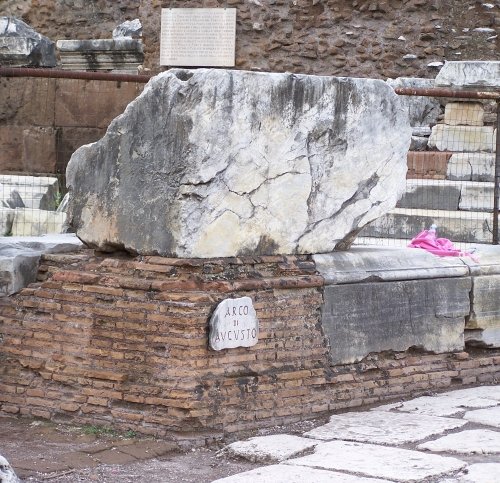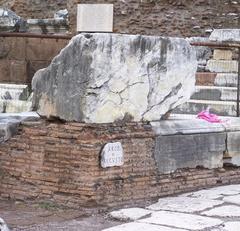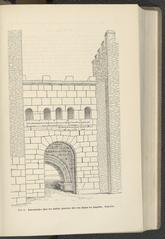
Arch of Augustus Rome Visiting Hours, Tickets, and Historical Sites Guide
Date: 14/06/2025
Introduction
Nestled amidst the ruins of the Roman Forum, the Arch of Augustus stands as a monumental testament to the dawn of the Roman Empire and the enduring legacy of its first emperor. Erected to commemorate Augustus’s victory at the Battle of Actium in 31 BCE, the arch not only marked a pivotal moment in Roman history but also set a new standard for monumental architecture and imperial propaganda. Although only its foundations and a handful of fragments remain today, the site’s historic resonance endures, drawing visitors who seek to retrace the footsteps of Rome’s illustrious past.
This comprehensive guide provides detailed information for travelers, history enthusiasts, and architecture lovers planning a visit to the Arch of Augustus. Here you’ll find essential details about visiting hours, tickets, accessibility, guided tours, nearby attractions, and expert travel tips. Whether you want to experience the echoes of ancient triumph or explore Rome’s archaeological heart, this article will ensure your journey is memorable and well-informed (Ancient Rome Live, Rome Tourist, Turismo Roma).
Table of Contents
- Introduction
- Historical Background
- Architectural Design and Layout
- Materials and Construction Techniques
- Decorative Elements and Symbolism
- Context within the Roman Forum
- Influence on Later Roman Architecture
- Visiting Information
- Nearby Attractions and Travel Tips
- Archaeological Discoveries and Museum Collections
- Conservation Efforts and Innovations
- Frequently Asked Questions (FAQ)
- Cultural Insights and Visitor Experience
- Conclusion and Final Tips
- References
Historical Background
Origins and Construction
The Arch of Augustus (Arcus Augusti) was commissioned by the Roman Senate in 29 BCE to honor Augustus’s victory over Mark Antony and Cleopatra. This event marked the end of the civil wars and the foundation of the Roman Empire. The arch was strategically erected at the eastern end of the Roman Forum, along the Via Sacra, symbolizing Augustus’s ascent and Rome’s transformation (rome-tourist.com).
A second, more elaborate triple-bayed arch was built in 19 BCE to celebrate Augustus’s diplomatic triumph in regaining the Roman standards from the Parthians—a symbolic restoration of Rome’s honor. While neither superstructure survives, their foundations and historical documentation provide insights into their significance (italy-tourist-information.com).
Architectural Features and Design
The Arch of Augustus was the first permanent triple-bayed arch in Rome, measuring approximately 17.75 meters wide. Its central passage was flanked by two smaller side bays, a design later emulated by other monumental arches, such as the Arch of Septimius Severus and the Arch of Constantine (ebrary.net). The central bay was vaulted, while the side bays featured horizontal entablatures and pediments, reflecting a blend of Roman and Hellenistic influences.
Historical and Cultural Significance
This monument was more than an architectural feat; it was a vehicle for Augustan ideology. Through reliefs, inscriptions, and statuary—including a quadriga statue of Augustus atop the central arch—the arch proclaimed military success, peace (Pax Romana), and a return to traditional values. The inclusion of the Fasti Consulares, marble panels listing Roman consuls, reinforced Augustus’s ties to Republican tradition and legitimized his rule (ebrary.net).
Architectural Design and Layout
Situated between the Temple of Castor and Pollux and the Temple of Divus Iulius, the arch was a visual and ceremonial anchor in the Forum. Its design integrated Roman construction methods and decorative styles from Asia Minor, featuring travertine foundations, marble superstructures, and ornate details such as S-shaped modillions, coffered soffits, and egg-and-tongue mouldings (Wikipedia).
Materials and Construction Techniques
The arch was supported by robust travertine blocks quarried near Tivoli. The superstructure likely included marble and high-quality limestone, reflecting Augustus’s ambition to transform Rome with monumental stonework. The combination of classicism and innovation in its construction influenced a generation of Roman builders (ebrary.net).
Decorative Elements and Symbolism
Reliefs depicted scenes of victory, submission of foreign peoples, and the return of the Parthian standards. Statues of Parthians adorned the pediments, while inscriptions proclaimed Augustus’s achievements. These elements served both as public art and as enduring tools of imperial messaging (ebrary.net).
Context within the Roman Forum
Erected at a key crossroads of the Forum, the arch reinforced Augustus’s connection to Julius Caesar and future heirs, underscoring dynastic continuity. The Forum itself underwent dramatic transformation during Augustus’s reign, with new temples and civic buildings that reflected the emperor’s vision (Turismo Roma).
Influence on Later Roman Architecture
The Arch of Augustus established the template for future triumphal arches, introducing the triple-bayed form and integrating sculptural programs that became hallmarks of Roman imperial monuments. Its legacy persisted in later public works, both in Rome and throughout the empire (ebrary.net).
Visiting Information
Location
The remains of the Arch of Augustus are found within the Roman Forum—Rome’s most renowned archaeological complex—between the Temple of Castor and Pollux and the Temple of Divus Iulius. The Forum is accessible via several entrances; the main one is on Via della Salara Vecchia, 5/6 (italy-tourist-information.com).
Opening Hours
- March 27 – August 31: 09:30 am – 7:15 pm
- September 1 – 30: 08:30 am – 7:00 pm
- October 1 – 30: 08:30 am – 6:30 pm
- October 31 – February 28: 09:00 am – 4:30 pm
- March 1 – 26: 09:30 am – 5:30 pm
- Closed: January 1 & December 25 (rome-tourist.com)
Tickets and Admission
- Standard Adult Ticket: €18 (as of June 2025), includes entrance to the Colosseum, Roman Forum, and Palatine Hill.
- Reduced Rates: Available for EU citizens aged 18–25.
- Free Entry: For children under 18.
- Where to Buy: Online in advance or at the site entrances. Advance purchase is recommended to avoid queues (rome-tourist.com).
Guided Tours
- Many guided tours of the Roman Forum include the Arch of Augustus. These tours are available in multiple languages and offer expert insights.
- Audio guides and mobile apps, such as the Audiala app, provide flexible self-guided experiences.
Accessibility
- The Roman Forum features uneven terrain and ancient paving stones; some accessible paths and ramps are available, but visitors with mobility challenges should contact the site in advance for assistance and current information.
Nearby Attractions and Travel Tips
- Major Nearby Sites: Colosseum, Palatine Hill, Temple of Julius Caesar, Arch of Septimius Severus.
- Travel Tips:
- Arrive early or visit late afternoon for cooler temperatures and fewer crowds, especially during peak months like June (Rome Actually).
- Wear comfortable shoes and bring sun protection.
- Use public transportation (Colosseo metro station) as parking is limited.
- Plan at least 2–3 hours to explore the Forum and adjacent sites.
- Local Amenities: Restrooms, water fountains, and cafés are available near the entrances.
Archaeological Discoveries and Museum Collections
Fragments and reliefs from the Arch of Augustus are preserved in several museums:
- Capitoline Museums: Fragments of the Fasti Consulares and marble decorations.
- Antiquarium: Decorative reliefs, including images of Victoria.
- Ny Carlsberg Glyptoteket (Copenhagen): Holds a notable relief from the arch.
For images, maps, and reconstructions, see Ancient Rome Live and Sights.seindal.dk.
Conservation Efforts and Innovations
Ongoing conservation work focuses on structural stabilization, cleaning, and interpretive improvements. Future plans include expanded digital resources, augmented reality, and enhanced visitor information to ensure both preservation and accessibility.
Frequently Asked Questions (FAQ)
Q: What are the visiting hours for the Arch of Augustus?
A: The Roman Forum is open daily with hours varying by season. Typically, it opens at 8:30 or 9:00 am and closes 1–2 hours before sunset. Check official sources for up-to-date schedules.
Q: How much do tickets cost?
A: Standard adult tickets are €18 and include the Roman Forum, Colosseum, and Palatine Hill. Reduced and free tickets are available for eligible visitors.
Q: Is the site accessible for wheelchair users?
A: Some accessible paths exist, but much of the terrain is uneven.
Q: Are guided tours available?
A: Yes, guided and audio tours are widely available and recommended for deeper context.
Q: Can I take photos at the site?
A: Yes, photography is permitted throughout the Roman Forum.
Cultural Insights and Visitor Experience
Visiting the Arch of Augustus is a journey through the heart of imperial Rome. Though only its foundations remain, the site’s historical footprint and interpretive signage allow visitors to envision its former grandeur. Exploring the surrounding Forum, with its dramatic ruins and evocative atmosphere, offers a powerful connection to the achievements of Augustus and the city’s enduring legacy (italy-tourist-information.com).
Conclusion and Final Tips
The Arch of Augustus exemplifies the transformative era of Rome’s emergence as an empire. While much of the original structure has vanished, its influence on architecture, art, and political symbolism continues to shape our understanding of ancient Rome. Careful planning regarding tickets, hours, and accessibility will enhance your visit, while digital guides and conservation efforts ensure the site remains a compelling destination for future generations.
To maximize your experience:
- Book tickets in advance.
- Download the Audiala app for expert audio guides and maps.
- Arrive early or late in the day for the best lighting and fewer crowds.
- Explore nearby sites for a full immersion in Rome’s ancient heritage.
For more tips and updates, follow official tourism websites and consider virtual tours for additional context.
References and Further Reading
- Ancient Rome Live: Arch of Augustus
- ebrary.net: Augustus and Roman Architecture
- Turismo Roma: Forum of Augustus
- Rome Tourist: Roman Forum
- Wikipedia: Arch of Augustus, Rome
- Italy Tourist Information: Roman Forum and Palatine Hill



















































































































































































































































